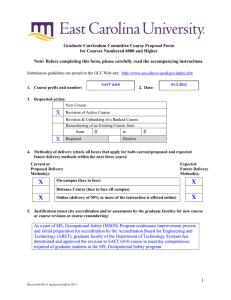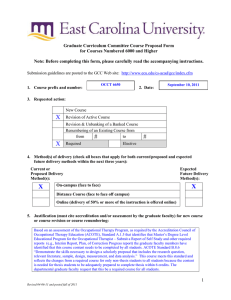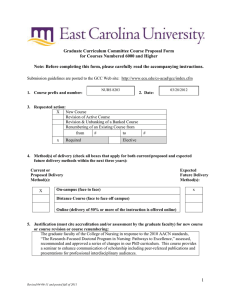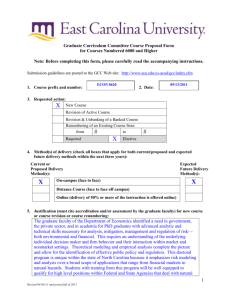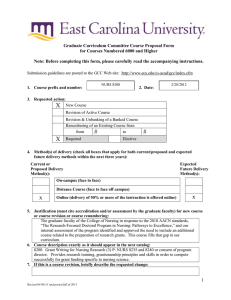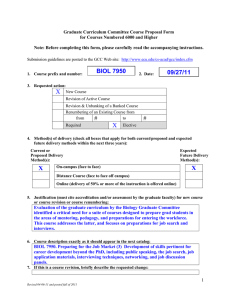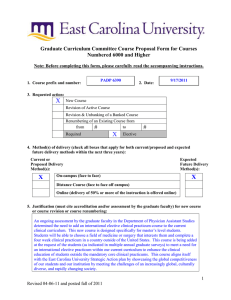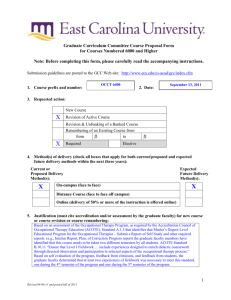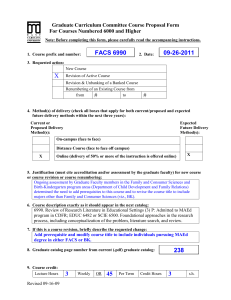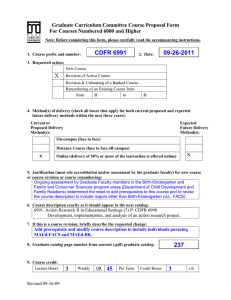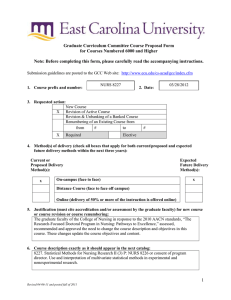Document 15476417
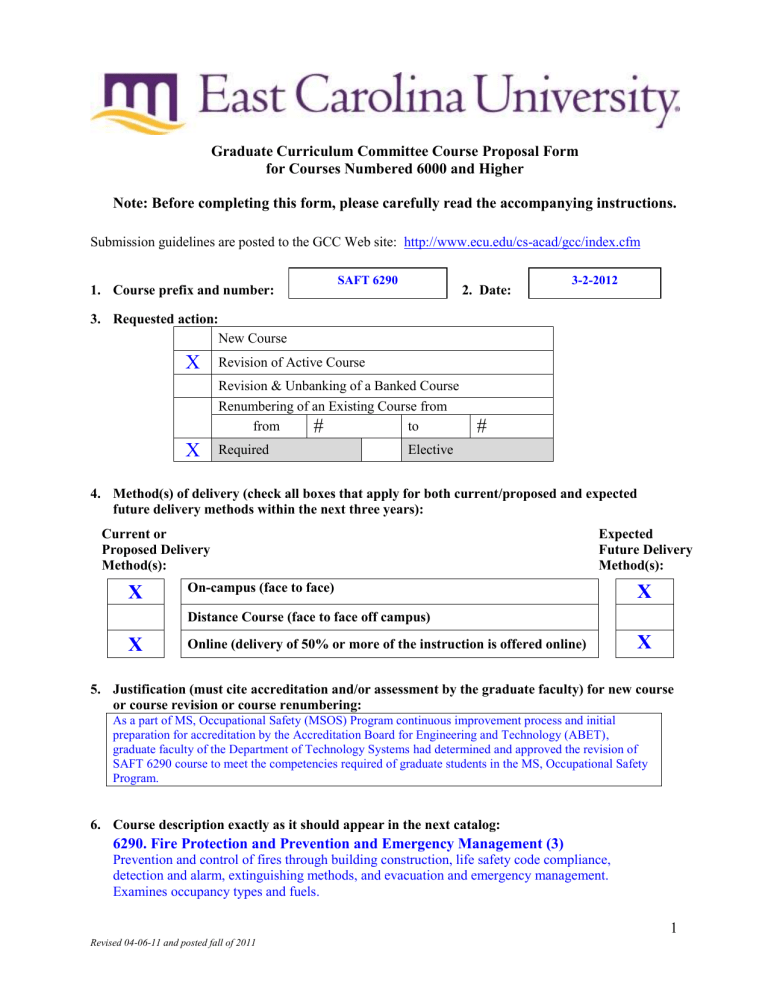
Graduate Curriculum Committee Course Proposal Form for Courses Numbered 6000 and Higher
Note: Before completing this form, please carefully read the accompanying instructions.
Submission guidelines are posted to the GCC Web site: http://www.ecu.edu/cs-acad/gcc/index.cfm
2.
SAFT 6290 3-2-2012
1.
Course prefix and number: 2. Date:
3.
Requested action:
New Course
X Revision of Active Course
Revision & Unbanking of a Banked Course
Renumbering of an Existing Course from
from # to #
X Required Elective
4.
Method(s) of delivery (check all boxes that apply for both current/proposed and expected future delivery methods within the next three years):
Current or
Proposed Delivery
Method(s):
Expected
Future Delivery
Method(s):
X On-campus (face to face) X
Distance Course (face to face off campus)
X Online (delivery of 50% or more of the instruction is offered online)
X
5.
Justification (must cite accreditation and/or assessment by the graduate faculty) for new course or course revision or course renumbering:
As a part of MS, Occupational Safety (MSOS) Program continuous improvement process and initial preparation for accreditation by the Accreditation Board for Engineering and Technology (ABET), graduate faculty of the Department of Technology Systems had determined and approved the revision of
SAFT 6290 course to meet the competencies required of graduate students in the MS, Occupational Safety
Program.
6.
Course description exactly as it should appear in the next catalog:
6290. Fire Protection and Prevention and Emergency Management (3)
Prevention and control of fires through building construction, life safety code compliance, detection and alarm, extinguishing methods, and evacuation and emergency management.
Examines occupancy types and fuels.
1
Revised 04-06-11 and posted fall of 2011
7.
If this is a course revision, briefly describe the requested change:
Including emergency management in the course title accurately reflects the evolving course contents and is congruent with ABET program outcomes for occupational safety and related degree programs.
8.
Course credit:
Lecture Hours
Lab
Studio
Practicum
Internship
3 Weekly OR Per Term Credit Hours
Weekly OR Per Term Credit Hours
Weekly OR Per Term Credit Hours
Weekly OR Per Term Credit Hours
Weekly OR Per Term Credit Hours
Other (e.g., independent study) Please explain.
3 s.h. s.h. s.h. s.h. s.h. s.h.
3 s.h. Total Credit Hours
9.
Anticipated annual student enrollment:
10.
Changes in degree hours of your programs:
15
Degree(s)/Program(s) Changes in Degree Hours
MSOS Program None
11.
Affected degrees or academic programs, other than your programs:
Degree(s)/Program(s) Changes in Degree Hours
Security Studies none
12.
Overlapping or duplication with affected units or programs:
Not applicable
X
Documentation of notification to the affected academic degree programs is attached.
13.
Council for Teacher Education (CTE) approval (for courses affecting teacher education):
X Not applicable
Applicable and CTE has given their approval.
14.
University Service-Learning Committee (USLC) approval:
X Not applicable
Applicable and USLC has given their approval.
Revised 04-06-11 and posted fall of 2011
2
15.
Statements of support: a. Staff
X Current staff is adequate
Additional staff is needed (describe needs in the box below): b. Facilities
X Current facilities are adequate
Additional facilities are needed (describe needs in the box below): c
.
Library
X Initial library resources are adequate
Initial resources are needed (in the box below, give a brief explanation and an estimate for the cost of acquisition of required initial resources): d. Unit computer resources
X Unit computer resources are adequate
Additional unit computer resources are needed (in the box below, give a brief explanation and an estimate for the cost of acquisition): e. ITCS resources
X ITCS resources are not needed
The following ITCS resources are needed (put a check beside each need):
Mainframe computer system
Statistical services
Network connections
Computer lab for students
Software
Approval from the Director of ITCS attached
16.
Course information (see: Graduate Curriculum and Program Development Manual for instructions): a. Textbook(s) and/or readings: author(s), name, publication date, publisher, and city/state/country. Include ISBN (when applicable).
Ferguson, L. and Janicak, C., (2005). Fundamentals of Fire Protection for the Safety
Professional.
Rowman & Littlefield, Ed. 1. ISBN 0-86587-988-5
Von Drehle, David, (2003). Triangle: The Fire that Changed America.
Grove Press, Ed. 1.
ISBN 0-8021-4151-x
Readings from selected literature
Revised 04-06-11 and posted fall of 2011
3
b. Course objectives for the course (student – centered, behavioral focus)
Upon completion of this course, students will be able to:
Apply knowledge of mathematics, science, and applied sciences to the field of
occupational safety.
Identify and solve applied science problems.
Communicate effectively and exhibit a high level of communication skills.
Anticipate, recognize, and evaluate hazardous conditions and practices affecting people, property, and the environment.
Develop and evaluate appropriate strategies designed to mitigate risk.
Contribute effectively and function in a team environment and on multi-disciplinary teams.
Apply selected writings and case studies in occupational safety to current situations in practice.
Demonstrate an understanding of the recognition of the need for, and an ability to engage in life-long learning. c. Course topic outline
Fire Chemistry & Physics
Common & Special hazards
Life Safety
Building construction
Explosions
Community Emergency Response Teams
Emergency Management
Weapons of Mass Destruction
Fire extinguishment
National Fire Protection Association Codes
Sprinkler Systems
Alarms and detection systems
All hazards concept / program mgmt
Process Safety Mgmt
Site inspection processes d. List of course assignments, weighting of each assignment, and grading/evaluation system for determining a grade
Group Works ......................................................... 10%
NFPA Code Analysis and Presentation ................. 10%
Mid-term exam ...................................................... 10%
Book report ............................................................ 15%
Fire / Life Safety Project and presentation ............ 25%
Final Exam ............................................................. 30%
Grading:
100%-90% ...................... A
89.9%-80% ..................... B
79.9%-70% ..................... C
69.9%-0 .......................... F
4
Revised 04-06-11 and posted fall of 2011
